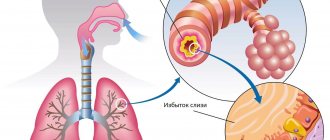Thrombophilia is a congenital or acquired pathological condition that is characterized by impaired blood clotting and an increased risk of blood clots. It is distinguished by its duration and sudden complications such as the formation of a blood clot in a vein, its fixation to the wall with the development of inflammatory processes (phlebothrombosis) or blockage of blood vessels by a blood clot (thromboembolism). Such conditions pose a danger to the health and life of the patient and require professional medical care.
At the same time, it is worth noting that thrombophilia cannot always lead to complications in the form of thrombosis or thromboembolism - however, the risk of their occurrence with this pathology increases significantly.
Thrombophilia - what kind of disease is it?
Thrombosis is the process of forming blood clots where the vascular wall is damaged; its purpose is to ensure the safety of the vascular system.
This process itself is physiologically normal; it prevents excessive blood loss at the sites of injury. But if the thrombotic process is excessive, then pathological thrombosis occurs. When answering the question of what thrombophilia is, we can give a clear example in the form of a photo that shows increased activity of blood cells and the formation of a blood clot. The disease is not always accompanied by thromboembolism or thrombosis, but the risk of blood clots in various places of the circulatory system greatly increases. Now modern medicine is concerned about the problem of this disease, since deaths quite often occur due to blockage of a blood vessel. The most commonly diagnosed hereditary thrombophilia is hereditary thrombophilia. According to statistics, in Europe about 15% of people suffer from this disease.
Do not confuse concepts such as thrombophilia and trypophilia. These are completely unrelated terms. But sometimes you can hear the question: trypophilia, what is it? The concept means phobia, fear of accumulation of objects with a rounded shape, cluster holes. So tripophilia is fear and discomfort associated, for example, with lotus seeds, honeycombs, and not a disease that manifests itself as pathologies in the body.
What is thrombophelitis and thrombosis
I am often asked about such a problem as vein blockage, what is meant by this concept. The fact is that such a simple, everyday word most often means such a dangerous complication as thrombosis. So, the vein in our leg has several membranes. The inner lining of the veins is represented by a thin layer of thin vessels. This layer of thin vessels is called the endothelium and this layer is nourished by oxygen from moving blood. Only moving blood, giving and taking oxygen, nourishes this membrane. If the movement of blood through the vein ends and the blood does not move or moves chaotically up and down, in this case phenomena arise that can lead to hypoxia of the inner lining of the vein wall, that is, the normal exchange of oxygen is disrupted. And this leads to the development of inflammatory phenomena. Inflammation in the wall of the vein, which occurs due to the adhesion of various formed elements to it, poor nutrition of the vein wall itself, and oxygen starvation causes and triggers a thrombus formation reaction. Formal elements begin to form in the area of the vein wall, sticking like a snowball to its wall. First of all, platelets. Platelets release active substances that form fibrin strands. And these fibrin threads, like a mesh, blocking the lumen of the vessel, cause the formation of a dense clot, which is called a thrombus or, in common parlance, a blockage of the veins. This thrombus itself can cause inflammation of the adjacent section of the vein and again everything will happen again, the formed elements will become inflamed again and the next section of thrombosis will become inflamed again.
Signs of thrombophilia
The disease often has no symptoms. Sometimes thrombosis occurs in the veins of the leg. This causes redness, swelling and discomfort. Such signs of thrombophilia are called deep vein thrombosis. Blood clots or blood clots must be treated with special blood thinners. This disease can be diagnosed in thrombophilia using devices that allow you to take photos, for example, to conduct an ultrasound examination.
Blood clots are not only dangerous to health, they can be fatal if they break off and enter the bloodstream to vital organs.
When a blood clot appears, the following symptoms appear:
- difficulty breathing;
- numbness of the feet and legs;
- chest pain when inhaling;
- heart attacks at a young age;
- swelling, pain at the site of thrombus formation - these are the most obvious symptoms of thrombophilia;
- cardiopalmus;
- coughing up blood;
- pregnancy disorders, constant miscarriages.
Types of disease
When answering the question of what thrombophilia is, it is necessary to understand that the development of the disease can depend on many factors. Its carriers, according to statistics, are almost two-fifths of the Earth's population. The disease is growing every year. There are two main types of pathology - congenital and acquired thrombophilia. With a hereditary disease, various abnormalities are found in genes. The most common factors are:
- deficiency of protein S and C, as well as antithrombin III. Proteins regulate the intensity of clotting, so if they are insufficient, excessive thrombus formation occurs. Antithrombin III creates compounds with thrombin, this leads to mutual inactivation. The component is one of the most important in the anticoagulant system;
- molecular abnormalities of fibrinogen;
- polymorphism of the V factor gene. A defect appears in the gene that carries information about the fifth blood clotting factor. This factor is also called the Leiden mutation;
- single nucleotide substitution G20210A;
- increased lipoprotein levels.
Thrombophilias that occur as a result of taking medications, injuries, or concomitant diseases are acquired. They do not arise unexpectedly and spontaneously; there is always a reason for the appearance of pathology.
- There are some other types of disease:
- hematogenous thrombophilia. Due to disturbances in blood composition, abnormalities in the coagulation system or platelet hemostasis, there is a tendency to repeated thrombosis of blood vessels of various locations. This is one of the most dangerous types of disease. The photo shows how a blood clot forms due to disorders caused by thrombophilia. It can cause thromboembolism, i.e. acute blockage of the vessel will occur. There are two types of hematogenous thrombophilias. The first group is associated with changes in the cellular composition of the blood and its rheological properties. The second group is associated with primary disorders in the hemostatic system;
- hemodynamic thrombophilia is associated with disorders of the circulatory system;
- Vascular thrombophilia includes diseases such as vasculitis and atherosclerosis.
Thrombophilia during pregnancy
It often coincides that hereditary thrombophilia and pregnancy manifest themselves simultaneously. This is due to the fact that a woman who is expecting a child develops an additional circle of blood circulation - the placental one, which has its own specific characteristics and puts an additional burden on the body. Thrombophilia is a disease in which the blood coagulation system is disrupted, leading to the possibility of serious complications, so pregnancy and thrombophilia are a dangerous combination that requires increased attention from women and doctors.
During pregnancy, a woman's body undergoes major changes, in particular, blood clotting increases. This is due to a decrease in blood loss during childbirth or such pathological conditions as placental abruption and miscarriage. With thrombophilia, the risk of blood clots is high, therefore, when it is also accompanied by physiological features of pregnancy in the form of increased coagulability, an even greater danger arises.
Often pregnant women experience a hematogenous type of disease associated with antiphospholipid syndrome. However, the course of the disease is usually unpredictable and there is no universal treatment regimen. Typically, thrombophilia may not manifest itself in any way, but during pregnancy the risk of thrombosis increases sixfold. The main danger can be a miscarriage at a short stage of pregnancy. This condition is fraught with the fact that blood clots can form in the vessels that lead to the placenta, which causes hypoxia and developmental delay in the fetus. The child’s body stops receiving nutrients, which leads to placental insufficiency, placental abruption, malformations, miscarriages and premature birth.
It is believed that the disease does not manifest itself in any way until ten weeks. There is no data on the effect of pathology on the development of pregnancy in the early stages. In the second trimester, thrombophilia usually also behaves calmly, and unpleasant consequences rarely occur. The risk of complications increases after 30 weeks, when placental abruption may occur.
If you are able to carry a child to term due to the disease, the birth usually occurs ahead of schedule, at 35-37 weeks. This scenario is considered favorable.
When making a diagnosis during pregnancy, the doctor should tell the woman what thrombophilia is and immediately prescribe treatment. The course of therapy consists of medications, a special diet and exercise. If you strictly follow all medical recommendations, the chances of carrying and giving birth to a healthy child are great. It is important to remember that preterm labor is likely to occur before 40 weeks. But with the modern level of medicine, babies born at earlier stages are cared for, so thrombophilia is not a death sentence for a woman who wants to have children. If you have a diagnosis of genetic thrombophilia, it is important to plan your pregnancy in advance, and then the risks of possible complications will be reduced.
If you notice similar symptoms, consult a doctor immediately. It is easier to prevent a disease than to deal with the consequences.
Classification
Modern medicine distinguishes two main groups of thrombophilias:
| Group I | Group II |
| Purchased and genetic thrombophilia due to increased viscosity and slower blood flow, as well as disturbances in cellular composition:
| Congenital and acquired thrombophilia due to primary disorders of the hemostatic system, which is “responsible” for maintaining the liquid state of the blood, dissolving blood clots that have already fulfilled their function. These include:
|
Diagnosis of the disease
Typically, diagnosing thrombophilia has a number of difficulties. This mainly happens because the disease may not manifest itself in any way and not give any symptoms. To clarify the disease, you need to contact a phlebologist; he uses a visual examination of the patient, hardware and laboratory diagnostics.
During the initial examination, the doctor determines the location of the damaged area and the degree of its changes. Typically, patients complain of swelling, hyperthermia in the area where varicose veins are located, and nagging pain after sitting or walking. On palpation, severe pain is determined. Based on these signs, the doctor prescribes a general blood test, tests for D-dimer content, and a coagulogram.
Laboratory analysis for thrombophilia includes the study of genes for platelet receptors, blood clotting factors, fibrinolysis, etc. In essence, genetic markers of thrombophilia are determined, which play an important role in the appearance of a congenital type of disease. There are two types of polymorphism - heterozygous and homozygous. The latter of these is considered more serious in terms of complications and treatment.
The need for testing for genetic markers is determined by a phlebologist individually and depends on the clinical picture. Indications for this laboratory diagnosis are:
- the presence of thromboembolic diseases at a young age;
- phlebeurysm;
- stroke and heart attack;
- cardiovascular diseases in close relatives;
- disorders associated with pregnancy: placental insufficiency, intrauterine growth retardation, fetal death, placental abruption, miscarriage, early miscarriages, toxicosis, severe forms of gestosis;
- use of oral contraceptives;
- recurrent thromboembolism;
- obesity.
Instrumental diagnosis of the disease is very informative. Computer programs provide detailed results on the condition of veins, valves, lumens, and thrombotic masses.
- Doppler ultrasound allows you to determine the speed and direction of blood flow in different parts of the vessel. This method does not provide the opportunity to study data on the structure and anatomy of veins.
- Ultrasound angiography of the lower extremities. The study is based on the ability of tissues to reflect and absorb ultrasound waves differently. The study is carried out only for serious indications, as it is an invasive diagnostic method. During the procedure, a contrast agent is injected into the vessel, the device tracks its movement, thereby creating a three-dimensional picture of all veins and arteries. It is recommended to perform angiography after Doppler sonography.
- Phlebography is an x-ray examination using an iodine-containing contrast agent.
- Phleboscintigraphy - the procedure is also based on the method of introducing a contrast agent, here it is a radioactive isotope with a short half-life.
- Spiral computed tomography is a new accurate diagnostic method. Allows you to create a volumetric 3D reconstruction and determine the condition and location of the veins. This procedure is indispensable for emergency diagnosis of thromboembolism.
- Magnetic resonance imaging.
After making a diagnosis, the doctor will tell you what kind of disease it is, thrombophilia, and prescribe the necessary treatment. Additionally, patients are prescribed a chest x-ray to prevent pulmonary embolism. Full diagnostics can be performed in any modern phlebological center
.
Our services in phlebology
The administration of CELT JSC regularly updates the price list posted on the clinic’s website. However, in order to avoid possible misunderstandings, we ask you to clarify the cost of services by phone: +7
| Service name | Price in rubles |
| Appointment with a surgical doctor (primary, for complex programs) | 3 000 |
| Appointment with a cardiovascular surgeon (phlebologist), MD. Malakhova Yu.S. with ultrasound examination (primary) | 4 500 |
| Duplex scanning of the veins of both lower extremities | 6 000 |
| Duplex scanning of the veins of one lower limb | 3 500 |
All services
Make an appointment through the application or by calling +7 +7 We work every day:
- Monday—Friday: 8.00—20.00
- Saturday: 8.00–18.00
- Sunday is a day off
The nearest metro and MCC stations to the clinic:
- Highway of Enthusiasts or Perovo
- Partisan
- Enthusiast Highway
Driving directions
Thrombophilia - treatment
Treatment of thrombophilia begins with the choice of a qualified doctor, his goal is to eliminate thrombotic complications.
Medications prescribed:
- anticoagulants (low molecular weight heparins), which reduce blood clotting;
- antiplatelet agents for the prevention of thromboembolism;
- drugs that improve liver function;
- fibrinolytic agents;
- folic acid has indications for certain types of disease;
- If there is a risk of cerebral edema, glucocorticoid drugs (dexamethasone) are recommended.
To prevent complications, it is recommended to use preventive measures. This is especially true during pregnancy:
- physical therapy classes;
- no heavy lifting or prolonged standing;
- wearing medical compression stockings or elastic bandages;
- swimming;
- electromagnetic therapy;
- self-massage;
- proper nutrition;
- phytotherapy.
For thrombophilia, it is recommended to do the following exercise: lying on your back, raise and lower your legs without sudden movements. It is possible to use hirudotherapy, where special medicinal leeches are used.
Treatment of thrombophilia during pregnancy
Often, it is during the period of waiting for a child that genetic thrombophilia manifests itself, so treatment of pregnant women with this diagnosis should be started as early as possible. In this case, approximately the same drugs are used as for other categories. The following primary and auxiliary medications are used in practice:
- Aescin;
- Nadroparin calcium;
- Troxerutin;
- Mannol;
- Dexamethasone;
- Fraxiparine;
- Femibion-2;
- Wessel Due F;
- Sometimes with APS, aspirin is prescribed to prevent thrombosis, as well as to prevent gestosis.
During pregnancy, there are certain indications for hospitalization of patients:
- antenatal hospitalization in an obstetrics and gynecology hospital for cerebral vein thrombosis;
- varicose veins are observed, in this case the patient is sent to a surgical hospital, the issue of maintaining or terminating the pregnancy is decided;
- patients are hospitalized in a neurosurgical hospital if an unspecified venous complication occurs.
Thrombophilia - treatment with folk remedies
Folk experience has collected many recipes, some of which will be useful for reducing blood clotting.
- Tincture of Sophora japonica. You need to take 100 grams of seeds and pour half a liter of good vodka over them. Leave for two weeks in a dark place. The product is taken 3 times a day before meals, 10 drops of tincture are diluted in a quarter glass of water.
- Grape juice has proven itself well; its daily consumption reduces platelet activity.
- Infusion of meadowsweet. Pour 2 teaspoons into a glass of boiling water, strain and drink one third of a glass before meals.
- It is useful to use infusions, jams, compotes from berries and raspberry leaves.
- Garlic is one of the unique natural remedies that can thin the blood, so you can include 2-3 cloves in your diet.
- Ginkgo biloba leaf extract is used.
- Multicomponent infusion. Chereda, St. John's wort 20 grams; coriander fruits, licorice root, marsh grass, chamomile, flaxseed, sweet clover 10 grams each. The mixture of herbs is poured into 500 ml of boiling water and left for 2 hours. Then the infusion is filtered and drunk, you can add honey. The dosage is 200 ml twice a day an hour after meals.
Herbs that have a blood-clotting effect, such as water pepper and nettle, should not be used in case of illness. Before using folk remedies, you should definitely consult a doctor; many of them have contraindications.
Folk remedies
A large number of folk recipes will help cope with the disease thrombophilia. Anticoagulants:
- Sophora japonica (tincture). Take 100 g of plant seeds. They are filled with good vodka (500 g) and infused for 2 weeks. Definitely in a dark place. Taken 3 times a day before meals. 10 drops of infusion are diluted in a quarter glass of water.
- Grape juice received good recommendations. It reduces platelet activity when consumed daily.
- Raspberries. Infusions and decoctions, jams and compotes from berries and plant leaves are an excellent preventive and therapeutic agent.
- Meadowsweet (infusion). Two teaspoons of herb are poured into a glass of boiling water. The broth is filtered. Drink a third of the glass before meals.
- Garlic is one of the unique plants that can thin the blood. That's why it is recommended to eat 2-3 cloves a day.
- Collection. It includes 20 g of St. John's wort and string; 10 g each of licorice root, coriander seeds, chamomile, marsh grass, toadflax, sweet clover. Everything is mixed, 0.5 liters of boiling water is poured. The decoction is infused for 2 hours. Strained. Use 2 times a day an hour after meals. The daily norm is 20 ml.
It is strictly forbidden to use plants that cause blood clotting - nettle, water pepper.
Before using traditional medicine recipes, consultation with a doctor is required. Many products have contraindications.
Diet for thrombophilia
In case of illness, a special antithrombotic diet is prescribed. It is necessary to limit foods that can increase blood viscosity. The diet should exclude the following foods:
- lard, fatty meat, rich broth;
- chocolate;
- whole milk;
- legumes;
- beef liver;
- hard cheeses;
- coffee, large amounts of green tea;
- celery, parsley, spinach;
- Do not eat spicy or fatty foods.
It is advisable to consume foods that reduce blood clotting:
- cranberries, viburnum, lingonberries, chokeberries;
- seafood;
- ginger;
- seaweed;
- red fruit drinks and juices;
- cereal porridges - pearl barley, oatmeal, barley, buckwheat,
- dried fruits - dates, dried apricots, figs, raisins, prunes.
Danger and risk factors
The development of the disease is influenced by a hereditary factor (genetic thrombophilia). But there are also some acquired risks:
- blood diseases. Erythremia, atherosclerosis, varicose veins of the lower extremities, arterial hypertension;
- diseases that affect motor activity (Schlatter's disease), malignant tumors, autoimmune diseases (antiphospholipid syndrome, systemic lupus erythematosus), polycystic kidney disease can indirectly affect the development of pathology;
- infectious processes;
- suffered a heart attack or stroke;
- surgical interventions;
- venous catheterization;
- liver diseases;
- obesity;
- pregnancy period;
- nephrotic syndrome;
- some medications (oral contraceptives, prednisolone).
Symptoms
The disease often occurs without any visible signs. Sometimes thrombosis can be diagnosed in the veins located in the lower leg. This disease provokes the appearance of redness, discomfort and swelling. They get rid of the problem with the help of special blood thinning medications. The disease with thrombophilia can be determined using ultrasound or x-ray.
Blood clots can be fatal if they break off and enter the bloodstream leading to vital organs.
The appearance of a blood clot is accompanied by the following symptoms:
- breathing is difficult;
- feet and legs go numb;
- chest pain appears when inhaling;
- rapid heartbeat and heart attacks at an early age;
- coughing up blood;
- frequent miscarriages;
- The most obvious sign of thrombophilia is pain in the area where the blood clot forms, swelling.
Prevention of complications of thrombophilia
No matter how professional a doctor is, you cannot shift responsibility for your health only to the achievements of modern medicine; it is important to remember that each person himself must also take care of it. In order to prevent complications from thrombophilia, you need to follow a number of simple rules:
- reconsider your lifestyle. Today, everyone who sits a lot and moves little is at risk of illness. Moderate physical activity, exercise, physical therapy will only improve your health;
- proper diet, avoidance of excessive consumption of fatty and smoked foods, as well as industrial semi-finished products;
- reduce the amount of meat consumed;
- special drinking regime - you need to drink at least one and a half liters of clean water per day;
- preventive medical examinations.
This article is posted for educational purposes only and does not constitute scientific material or professional medical advice.
Symptoms of venous thrombosis of the lower extremities
So, this process can take a very long time and externally manifests itself as redness on the skin, a sharp thickening of the skin itself and soreness. Thus, if you see a red spot on your leg, this may, unfortunately, mean the beginning of the process of inflammation or blockage of the vein. And this is the beginning of the inflammatory process, which is formed by venous stagnation. In truth, it is not only the venous capacity itself that forms a person’s tendency to thrombosis, very often thrombotic changes are observed with high cholesterol. Cholesterol can cause damage to the vein and the formation of a blood clot. And our patients also need to remember this.









